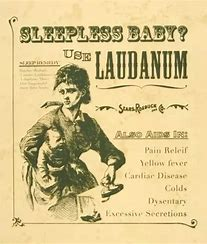Alcohol wasn't the only thing that might be a problem...
Queen Victoria, who is often thought of as prim and staid, liked to use laudanum lozenges and chewed "medicinal cocaine gums " with Winston Churchill. Oh, yes!... Victoria liked her drugs.
We think of Victorians as being proper... They were casual about many things that they didn't know were so harmful.
It was thought to be a great help for nervous complaints, insomnia, headache. I'm sure it was... Have menstrual cramps???, --- a few spoonfuls of laudanum.

Pharmaceutical Use of Cocaine
History of Cocaine: Circa 1860s–1900

As cocaine became a popular ingredient in alcoholic drinks, scientists and pharmaceutical companies were investigating possible medical uses for this drug.
German pharmaceutical company Merck began producing very small amounts of the drug in the early 1860s. Total output through the late 1870s was only about 50 grams a year. In the US, pharmaceutical company Parke Davis also began producing the drug.
Then in the 1880s, medical uses of the drug began to be revealed. For example, Merck’s promotional materials touted the drug as a remedy for the morphine addiction suffered by many former Civil War soldiers.
One of the early enthusiasts for the drug was Sigmund Freud who was eager to gain fame and wealth so he could marry. He was interested in the opportunity offered by this new drug and began to experiment on himself and friends. He wrote to his fiancee, “I take very small doses of it regularly against depression and against indigestion and with the most brilliant of success.” Dr. Freud used this drug on himself and his associates for the next decade and wrote his glowing praise for cocaine in the 70-page report “Uber Cocaine.”
In 1884, cocaine’s value in performing eye surgery was discovered by Freud’s friend Dr. Koller. The drug not only numbed the eye but restricted bleeding because it tightened up blood vessels. This development was another step forward in the popularity of cocaine in medical use.
Production of cocaine began to increase greatly in response to increased medical use. In 1883, Merck produced only four-tenths of a kilo of the drug. By 1885, their production had rocketed to 83,343 kg. This increase began just two months after Dr. Koller’s report on cocaine for eye surgery was published.

As further applications (valid or not) were discovered, the popularity of this drug grew rapidly. Along with pharmaceutical applications, over the counter preparations also began to include cocaine.
Patent medications containing cocaine:
Cocaine toothache drops, “Instantaneous Cure!”
Metcalf’s Coca Wine “for fatigue of mind or body”
Voice “Tabloids” with cocaine, chlorate of potash and borax
Chemists at Parke Davis developed a refinement system that called for partial refinement on site in South America, with the remaining refining taking place at the pharmaceutical company. This discovery made the cocaine industry much more viable, as potency would not be lost while shipping the coca leaves from South America to the US or Europe.
In 1887, the US Surgeon General recommended that cocaine be used to treat depression, claiming that there was no such thing as cocaine addiction.
Cocaine’s Damage Begins to Show Up

In one incident after another, cocaine’s addictiveness and physical damage began to show up. Young New York surgeon William Halsted began to investigate its use in surgical procedures. He tested the drug by injecting it into his own arms and legs and the limbs of friends and students, using the hypodermic needle invented in the mid-1800s. Halsted quickly became a non-functional addict and could not practice medicine any longer.
Freud’s experimentation had its hazards, too. One associate, Ernst von Fleischl-Marxzow, had been dealing with a hand injury with large doses of morphine. Dr. Freud’s administration of cocaine as a solution for the man’s morphine addiction turned him into an addled, morphine-cocaine addict who died seven years later. He was the first person known to suffer the paranoia and delusions of bugs crawling under the skin that are common to heavy cocaine addicts.
In 1895, Freud was still abusing cocaine. While under the influence, he and a colleague performed surgery on Emma Eckstein. The surgery went bad, in part because of the Freud’s cocaine abuse. While Emma survived, this nearly-fatal error seems to have haunted Freud and led him eventually to give the drug up, despite all its apparent benefits. But by the time Freud gave up the drug, its use had already spread far and wide.
It would be another 17 years before the danger of the drug was recognized sufficiently to make it a controlled substance.
The US Makes the Drug Illegal
In 1914, the Harrison Narcotics Act rounded up a list of drugs that had been used in patent medicines or pharmaceutical compounds and put them under federal control. Cocaine was on the list. This change meant that those who were now addicted to cocaine could be arrested if they possessed the drug.
Despite reports of some increased use during Prohibition, cocaine was not a newsworthy topic until the second half of the Twentieth Century when cocaine began pouring into the US from South America.










No comments:
Post a Comment